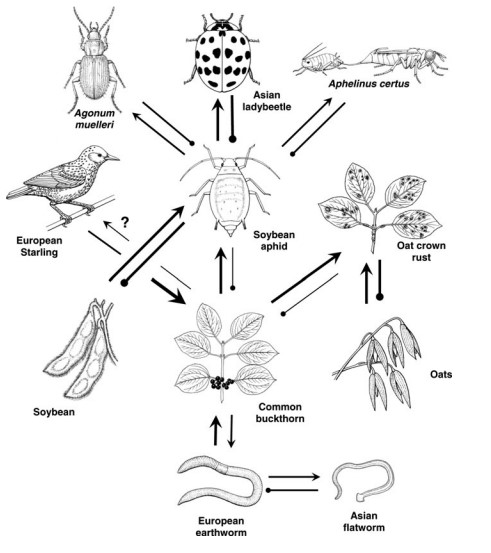Environmental activists have moved on from saving bees, just like they have moved on from endorsing hydroelectric power, natural gas, and biofuels. Once the thing they lobbied for is in use, the money is in saying it is all killing us. Like they now do with hydroelectric power, natural gas, and biofuels.
With bees in higher numbers than ever, it is time for doomsday prophets to move on, perhaps to saving...an obscure non-native wasp species? Yes indeed, a recent Penn State press release warns us that neonicotinoid pesticides - derived from the natural nicotine in tobacco plants that pests dislike - "can contaminate honeydew, which is an important food source for beneficial insects in agroecosystems."

This is the environmental meltdown linked to invasive species the authors have rebranded as "beneficial insects"
Honeydew? They don't mean the melon, they mean aphid poo. Which the invasive species of wasps eats.(1)
The environmental apocalyptic chain of events due to a targeted pesticide that has been much better for the environmental than mass spraying is this:
1. Crop-destroying aphids sometimes eat soybean grown from treated neonic seeds, but don’t die. That's right, the authors are implicitly criticizing the insecticide for not being toxic enough.
2. The hearty crop-destroying aphids excrete ‘honeydew’ that supposedly contains neonics from eating the plant.
3. Parasitic non-native wasps eat this honeydew.
4. Some wasps died faster than average.
That is worth them writing about? If you are going to politicize science it is important to publish even if “The longevity of A. glycinis females was not statistically different between the three honeydew types.”
The three types were honeydew from plants treated with TMX, TMX+fungicide, and untreated. A. certus wasps in the study had their median lifespan shortened from 17 days to 14 days. (2)
They are calling for a shutdown of modern agriculturre because of three fewer days of non-native parasitism. Yet despite this being a paper that weirdly finds 3 days less of an invasive species parasite is a bad thing, environmentalists are going to sound the alarm over this impending crisis. Because this invasive species can be a biological pest control.
It is going to be fun to see them roll out a campaign endorsing biological pest control because
while Rachel Carson, author of the famed environmental plea "Silent Spring", loved the idea of biological pest control over chemicals, modern activists hate GMOs, RNAi, CRISPR and most all science. They hate biology. The only modern plant biology they accept is mutagenesis, even though those are mutants literally created by bathing plants in chemicals and radiation. Those plants they certify "organic."
In case there is still any doubt about the political nature and goal of the study, even if you know they did part of this to try and legitimize a 2019 paper that was debunked because the test case couldn't exist in the real world, I present their own conclusion:
“Nowadays, only the European Union (which represents less than 4% of the global agricultural land) has banned the application of neonicotinoids after a risk assessment report carried out by the European Food Safety Authority. This risk assessment, as well as others carried out by other environmental agencies, did not consider honeydew as route of exposure to beneficial insects. This route is especially relevant because environmental agencies are now evaluating the use of neonicotinoid coated-seeds in crops that are harvested before the flowering period, without considering that these plants can hold phloem-feeding herbivores that excrete contaminated honeydew as we demonstrate here under field conditions. Therefore, honeydew should be included in future environmental risk assessments as a route of exposure to neonicotinoids applied as seed coating.”
There is an upside to all this. I get to start referencing my honeydoo when I talk to my wife after a morning coffee. I hope you are also moved by how poorly designed this study is.
NOTES:
(1) Geckos too.
(2) The authors simulated this chain of events by stuffing around 120 “newly emerged and unfed female adult” wasps into a test tube and forcing them to eat nothing but honeydew from plants grown from neonic seeds (or the untreated control). If they ate everything and survived, well, those results are tossed. Bugs with the strength to bug out were also uncounted: “We censored those beneficial insects that escaped, died for other reasons, or had finished all the honeydew administered in one day (honeydew not ad libitum)… For A. certus, we censored nineteen females out of 116 that escaped or died for other reasons and five because honeydew had not been administered ad libitum.”
It is hard to tell the public to accept the science of a COVID-19 vaccines when this mishmash methodology is also peer-reviewed.





Comments